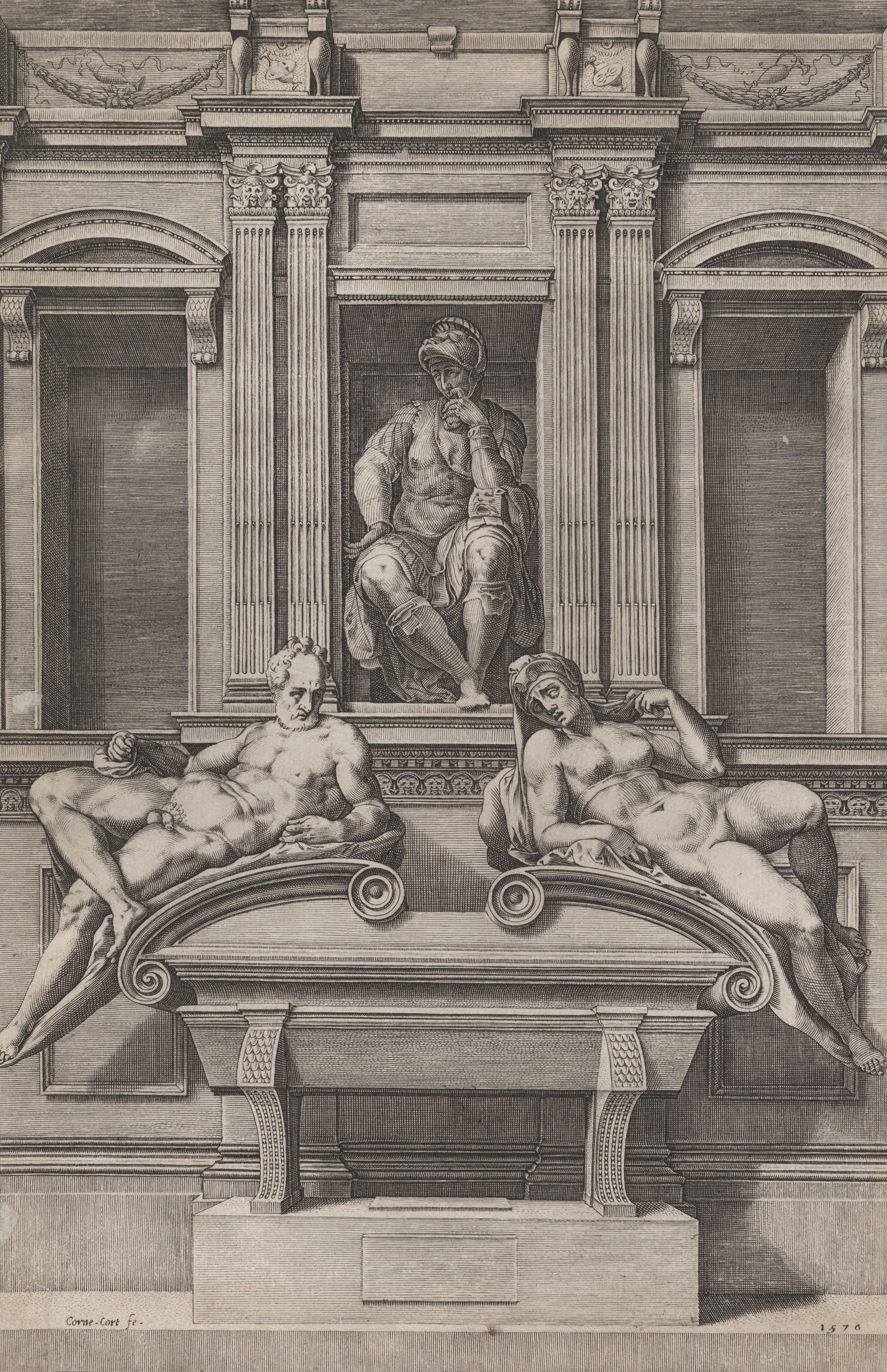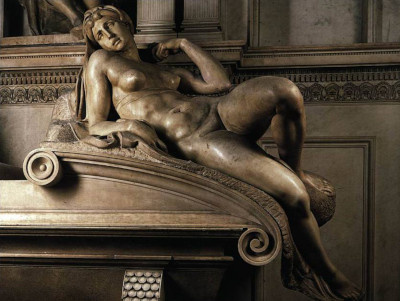Introduction
Dawn and Dusk complete a triangular layout of sculptures, flanking either side, and just below the sculpture of Duke Lorenzo himself. A similar format is used again for the Tomb of Duke Giuliano, with Night and Day sculptures angled in much the same manner. Michelangelo's work on these projects can be considered amongst the highest profile of his career, due to the significance of the Medici family within Italian history.
The Medicis themselves had financed the arts for many generations, bringing opportunities to the finest artists from around the country, and helping to raise the bar within Renaissance Italy. It would therefore be fitting for members of the family to be buried amidst work by Michelangelo, perhaps the finest sculptor to have ever lived. Whilst visitors to these tombs will typically consider only the overall presentation, we will examine each sculpture individually, starting with Dawn below.
Michelangelo, it must be remembered, failed to complete a number of commissions within his career, sometimes for reasons of his own making, and sometimes the fault of others. Politics and money were heavily involved within artistic circles during this period, and the religious institutions that also directed some of his work could also complicate matters. Therefore, it is to be appreciated that his work within these tombs for the Medici family were successfully completed and also well preserved in later centuries.
Table of Contents
- Introduction
- Description
- Meaning
- Michelangelo's Work on the Tomb of Lorenzo de' Medici
- Condition and Completeness
- Size and Medium
Description
Dawn features a young, slim woman reclining on her back, leaning slight to her right side as she looks in our direction. Her right arm supports her weight in this posture, whilst her left hand appears to be playing with her hair in an alluring manner. Her legs stretch out, reaching down to the supporting elements of the tomb itself, with her right leg hanging over the side.
The figure representing Dawn can be viewed from multiple angles, due to the nature of this tomb, though most will typically look from front-onwards. Michelangelo typically considered how his sculptures would appear from different angles, and in this case both Dusk and Dawn are slightly in front of the many portrait sculpture, allowing visitors to view them from behind, slightly to the side.
Both male and female figures produced by Michelangelo would be slim and toned, typically, and in this case we see a female with a flat stomach and a small suggestion of muscle mass. Michelangelo rarely depicted nude women within his sculptures, making this an important addition to his oeuvre, and was also more knowledgeable on the male body, as that took most of his focus. Despite. that, Dawn is still a highly impressive statue which is well designed in order to perfectly fit into the overall design of the tomb.
Within the Tomb of Lorenzo de' Medici, Dawn sits on the right hand side, as one would look at it from face-on. Dusk is then placed on the opposing side, and matches the same structure, ensuring a consistent layout and balance. Michelangelo was fairly with this approach of producing individual sculptures that would fit into a larger structure, having helped to finish off Basilica of San Domenico several decades earlier after the existing sculptor had passed away suddenly.
As Michelangelo's career progressed he was able to pick and choose the commissions that came his way, and was less likely to take on something like the project in Bologna, where he was forced to conform to the earlier contributions of other artists. Within his work for these Medici tombs, Michelangelo was given far more artistic license, reflecting the confidence that donors now had in his abilities.
Meaning
Of the theories put forward by scholars regarding the meaning of Michelangelo's Dawn, the most believable is that it represents the mourning of the death of Lorenzo de' Medici. The evidence for this is in the veil worn by the female figure, as well as the supposed sadness which appears in her body position and facial features. It was Vasari who first put forward this view, and much of what we know about the Renaissance masters comes from his early publications. He was not only one of the earliest art biographers, but also a skilled artist himself, which helped him to move between the various Italian art circles, documenting their lives as he went (see Vasari's Lives of the Artists).
Michelangelo's Work on the Tomb of Lorenzo de' Medici
We do know that Michelangelo likely completed his work on Dawn earlier than Dusk, with the latter possibly being tweaked for several years after. His portrait of Lorenzo was carried out in 1525, whilst Dawn is loosely dated to around 1524 up to 1527. Michelangelo always struggled to focus on one sculpture at a time, and so the period of several years would have been due to becoming distracted by other elements within the tomb, and potentially other projects elsewhere in the city.
The tomb of Lorenzo features the figures of Dusk and Dawn who lay on top of the sarcophagus. Lorenzo sits above them and is portrayed wearing armour and a helmet. The design allows the three sculptures to form a triangle and a similar format was used for the tomb of Giuliano de' Medici which was completed during the same time period. The history of Renaissance sculpture and architecture is littered with projects that have been passed on to multiple contributors, and so it was wise to employ Michelangelo for an intensive period in which most of the work could be completed at the same time. This helped to achieve a strong feeling of artistic consistency across the two tombs which line the east and west wall.
 Engraving Print of the Tomb of Lorenzo de' Medici by Cornelis Cort, 16th Century (Image contributed by the Metropolitan Museum of Art to Wikimedia Commons and dedicated to the public domain.)
Engraving Print of the Tomb of Lorenzo de' Medici by Cornelis Cort, 16th Century (Image contributed by the Metropolitan Museum of Art to Wikimedia Commons and dedicated to the public domain.)
Who was Lorenzo de' Medici?
Lorenzo de' Medici played a crucial role in financing the Italian Renaissance, and was driven by a strong and genuine passion for the arts. He served as a statesman, and became known as the unofficial ruler of the Republic of Florence. With Italian politics being as turbulent as it was during the 15th century, Michelangelo's connection to this powerful figure would become both a help and a danger. The Florentine ruler considered Michelangelo to be one of his favourite artists of all, but would commission a great number across his lifetime for a variety of projects.
In some cases, such as Sandro Botticelli's Madonna of the Magnificat and The Adoration of the Magi, these great masters would include members of the Medici family within the paintings or sculptures themselves, but in most cases Lorenzo liked to give them as much artistic license as possible and would, no doubt, have approved of Michelangelo's involvement upon his own tomb.
Condition and Completeness
Whilst we laud Michelangelo for finishing this project, as opposed to some of the other commissions in his career which were abandoned at various stages of completeness, it must be remembered that some small sections of Dawn were actually still left with work to do. This is particularly noticeable around her feet, though most visitors to the tomb today will not spot this. The overall display is a significant addition to Italian history, both in an artistic sense, but also in its representation of the highly significant Medici family, and this has ensured its preservation up to the present day. Dawn remains in relatively good condition, considering its age.
Size and Medium
Michelangelo's Dawn statue is also sometimes known as Aurora. It was constructed between the years of 1524-1527, though the artist would have been involved with a number of other projects during this period. It was made entirely from marble, and measures a total of 206 cm in length. Whilst Dusk on the opposing side is similar in many ways, their sizes were not identical, as Michelangelo allowed himself a good level of independence between each piece.
Image Credit
The image of Michelangelo's Dawn included within this page was contributed to Wikimedia Commons by Eos under the Creative Commons Attribution 3.0 Unported license. Their contribution is much appreciated, and helps us all to appreciate the work, even if we are unable to view it in person in Italy. We recommend that you browse some of their other contributions, with a number of other key Michelangelo sculptures and other Renaissance art and architecture also covered.
Dawn, 16th century by Michelangelo, from the tomb of Lorenzo de' Medici; Eos, CC BY 3.0, via Wikimedia Commons
Bibliography
- Images sourced from Wikimedia under a variety of Creative Commons licenses. Further details regarding the particular license used, the location of the original image on Wikimedia and the original author/user are provided on each specific page.
- Michelangelo, Gilles Néret
- Vasari's Lives of the Artists, Giorgio Vasari
- Michelangelo. The Complete Works. Paintings, Sculptures, Architecture, Frank Zöllner, Christof Thoenes
- Michelangelo and the Sistine Chapel, Andrew Graham-Dixon





